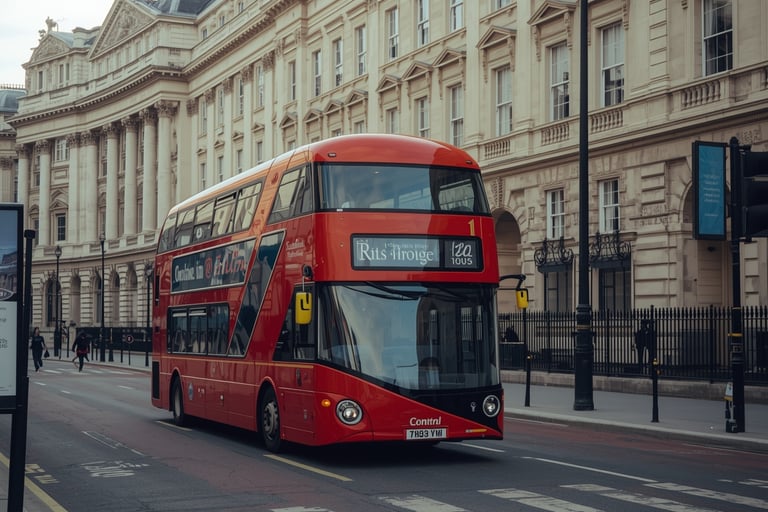How to Get Around London: A Budget Backpacker’s Guide
London is massive, historic, and bustling with life, but don’t let the city’s size or reputation for high prices scare you off. For budget travelers, moving around London efficiently is key to squeezing the most out of your trip without breaking the bank. Whether you’re hopping on the Tube, catching a bus, walking through scenic neighborhoods, cycling along the Thames, or exploring the city by riverboat, this guide will give you practical tips and sample itineraries to make your time in London smooth, cheap, and fun.
10/26/20255 min read


Why London Transportation Doesn’t Have to Be Expensive
Many first-time visitors assume that traveling around London means expensive taxis or overpriced tours. The reality is quite different: London has one of the most extensive public transport networks in the world, and with a bit of planning, it’s both affordable and convenient.
Budget travelers can combine Oyster cards, day passes, and walking routes to see iconic sights without spending a fortune. Plus, cycling and river transport give you a unique view of the city that’s often missed by typical tourists.
By the end of this post, you’ll know exactly how to get from Tower Bridge to Camden, from Westminster to Greenwich, and everywhere in between — all while keeping your backpacker budget intact.
Getting Started: Your Essentials
Before diving into different transport modes, there are a few essentials every budget traveler in London should have:
Oyster Card: The must-have for easy access to the Tube, buses, and some trains. You can order one online or pick one up at any major station. [Affiliate link example: “Get your Oyster Card online before you go”].
Contactless Payment Card: Most debit/credit cards work like Oyster, and daily caps ensure you won’t overspend.
Comfortable Walking Shoes: You’ll be surprised how much walking is actually faster and cheaper than hopping on the Tube for short distances.
City Map / Google Maps Offline: Essential for navigating zones and planning routes without burning data.


The Tube: London’s Lifeline
How It Works
The Tube (London Underground) is the fastest way to get across the city. With 11 lines covering Greater London, you can travel almost anywhere in under 30 minutes.
Tips for budget travelers:
Avoid peak hours (7–9:30 AM, 4:30–7 PM) to save on stress and sometimes money.
Use a day cap: With an Oyster or contactless card, you’ll never pay more than £8–£9 for unlimited travel within zones 1–2 per day.
Plan ahead: Some stations, especially popular ones like King’s Cross, Leicester Square, or Westminster, can be crowded.
Sample Tube Itinerary: Day 1
Morning: Take the Tube to Westminster Station. Walk to Big Ben, Westminster Abbey, and the Houses of Parliament.
Afternoon: Jump on the Jubilee Line to London Bridge Station. Explore Borough Market and cross the iconic Tower Bridge.
Evening: Take the Tube to Covent Garden for street performers, dinner, and evening strolls


2. Buses:
Affordable, Scenic, and Iconic While the Tube is fast, buses are often more scenic. You can see streets, architecture, and neighborhoods you’d otherwise miss underground. Bus Essentials Oyster or contactless card works on buses too. Flat fare: £1.75 per ride (for any distance in London). Night buses: Good alternative if you’re exploring late without paying for taxis. Sample Bus Itinerary: Day 2 Take bus 15 from Trafalgar Square to Tower of London. This route passes iconic streets and buildings. Hop on bus 24 toward Camden Town. Explore Camden Market and Regent’s Canal. Evening: Bus 19 from Camden to King’s Cross for a budget dinner and evening walk. 💡 Tip: Sit on the top deck for the best sightseeing experience — it’s like a mini-tour without paying extra.


3. Walking: The Cheapest and Most Rewarding Way
London is surprisingly walkable, especially central areas like Westminster, Southbank, Covent Garden, Soho, and Camden. Walking lets you discover hidden gems, small cafés, street art, and quieter streets.
Sample Walking Route: Southbank & City
Start at London Eye → walk along Southbank past the National Theatre, Tate Modern, and Shakespeare’s Globe.
Cross the Millennium Bridge for panoramic views of St. Paul’s Cathedral.
End near Borough Market for an affordable dinner.
💡 Tip: Walking short distances (10–20 minutes) often beats taking the Tube — you save money and see more of the city.


4. Cycling: Explore Like a Local
London’s Santander Cycles (aka “Boris Bikes”) are a great option for short trips:
£2 to unlock, then 30 minutes free per ride.
Stations everywhere; return to any docking point.
Ideal for exploring parks, riverside paths, and areas like Regent’s Canal, Hyde Park, or Greenwich.
Sample Cycling Itinerary: Day 3
Rent a bike at Tower Bridge.
Cycle along the Thames Path toward Greenwich.
Stop at Greenwich Park and the Royal Observatory.
Return bike at the nearest docking station near your hostel or station.
💡 Tip: Cycling is faster than buses for short trips, and you get a fresh perspective of the city.


5. River Boats: Unique & Fun
For a scenic alternative, take Thames Clippers or commuter riverboats:
Stops include Tower, London Eye, Greenwich, Canary Wharf.
Slightly pricier than buses but cheaper than taxis (£7–£10 one-way).
Great for photos of landmarks from the water.
Sample Riverboat Day
Start at Greenwich Pier, head upstream to London Eye Pier.
Walk along Southbank, enjoy street performances, and grab food.
Evening: Return by riverboat or continue by Tube to your hostel.
💡 Tip: Some riverboats allow Oyster payment; it’s convenient for combining multiple modes.


6. Day Passes & Multi-Mode Tips
Oyster daily cap (zones 1–2): ~£8–£9
Travelcards: Good if you plan multiple trips outside zones 1–2
Bus + Tube combo: Oyster caps combine Tube + bus fares
Walking + public transport combo: Often the fastest and cheapest
💡 Pro Tip: For day trips outside London, check National Rail’s off-peak tickets. Some come with Oyster integration or discounted passes.
Sample 3-Day Transportation Itinerary
Day 1 – Westminster & Southbank
Tube: Westminster → London Bridge
Walk: Tower Bridge → Borough Market → Millennium Bridge → St. Paul’s Cathedral
Evening Tube: Southbank → Covent Garden
Day 2 – Camden & Markets
Bus: Trafalgar Square → Tower of London → Camden
Walk: Explore Camden Market & Regent’s Canal
Optional: Evening bus to King’s Cross
Day 3 – Greenwich & Riverside
Cycle: Tower Bridge → Greenwich Park → Royal Observatory
Riverboat: Greenwich Pier → London Eye
Walk: Southbank stroll + dinner
This mix of Tube, buses, walking, cycling, and riverboats ensures you see all major landmarks, save money, and enjoy London like a local.
Final Thoughts
Navigating London doesn’t have to be stressful or expensive. Oyster cards, buses, walking, cycling, and riverboats give you multiple options to tailor your day according to pace, budget, and sightseeing priorities.
For backpackers, the key is flexibility: combine walking with public transport, use day passes wisely, and sprinkle in cycling or riverboats for unique perspectives.
With this guide, you can confidently explore London for three days, hitting all the iconic sights, markets, parks, and neighborhoods, without spending a fortune. Grab your Oyster, lace up your shoes, and get ready to experience London like a savvy backpacker!
